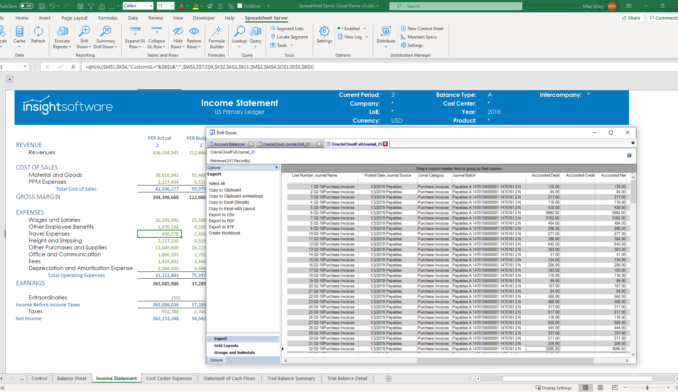Global Banking & Finance Review: What Story Does the Office of the CFO Need to Tell Now?

The Office of the CFO sits at the heart of business strategy if it is operating productively and effectively. But how do you get to that level, particularly during uncertain times?
In our world, the most successful finance teams and CFOs are champions of something called “financial intelligence,” which underpins everything they do.
Financial intelligence isn’t software: It’s how best-in-class finance teams operate. It’s not something that sits in the weeds—numbers are only part of it—it’s a more strategic, higher level of thinking, including the use of storytelling to guide decision-making. In the last few months, this level of thinking has been tested more than ever before.
A New Look
The skillset in the Office of the CFO is changing. It now includes data scientists and strategists, alongside the traditional controllers and accountants, meaning there are many more people looking at numbers. But without establishing a centralised rapid reporting rhythm, fed by real-time data and supported by automated reporting processes, finance runs the risk of things dropping off into silos. And that’s the last thing you want during in periods of uncertainty where things are changing on a daily basis.
According to the Accenture CFO survey, 76% of CFOs believe that without a single version of the truth, their organisation will struggle.
Furthermore, a 2018 McKinsey survey said that the number of functions reporting to CFOs has risen from four to six since 2016. During that same period, twice as many CFOs report having primary responsibility for their company’s digital initiatives. That would have been unheard of at the turn of the century.
So how do you navigate this demand for centralised data and agility in changing economic conditions, as well as the growing number of roles appearing in the Office of the CFO?
A New Playbook for the Office of the CFO
The Office of the CFO remains the nexus of a company’s financial data ecosystem, so it makes sense for that evolving team to take the lead in re-imagining how data reporting works and prioritising an agile, collaborative way of working.
When armed with the right information, the Office of the CFO becomes something different altogether: a team of storytellers for the wider business.
But what does storytelling have to do with numbers?
The Office of the CFO is charged with assembling data into a clear and accurate story of the company’s performance, and the coronavirus pandemic is the ultimate test for creating that narrative. Analysing the numbers drives the story and helps raise the level of financial intelligence across the organisation.
Like any good story, this story will follow a linear arc: where the company has been, where it is right now, and where it could head in the future.
It is likely that COVID-19 has had a significant impact on the revenues and profitability of many businesses. Covenant reporting, trading updates, potential M&A activity, and annual reports are likely to require an assessment, looking at the full impact of the pandemic. This assessment will need to consider both incremental costs, which may be classified as exceptional, and also lost revenues and profits. A robust way to evidence and explain the impact—which goes beyond comparing budget to actuals—will be critical to providing a credible narrative on the impact to the business. Storytelling has never been more important.
Unleashing Financial Intelligence through Automation
Enabling people to be effective storytellers means allowing them time and space to analyse the numbers and create the narrative. This requires freeing them up from the mundane, time-consuming aspects of financial reporting where static data is often imported from the financial system into Excel and then manually manipulated and formatted into a finished report. Automating this reporting process will increase the productivity of the finance team, enabling them to spend more time on analysis and storytelling.
Investing in world-class, automated financial reporting software means organisations have 49% fewer reports, half the number of FTEs focused on producing business performance reports, and spend 1.4 fewer days in the reporting cycle, according to the Hackett Group Business Performance Report 2018. And with these time savings and lower spend, the Office of the CFO can dedicate more time to the story that matters: how the business moves forward after this pandemic.
What You See is What You Get
For maximum effectiveness, the narratives that your finance team create also need to be aesthetically pleasing, especially if you need a non-financial audience to grasp the crux of a story – and there could be a wider audience keeping a closer eye on performance now.
Humans are very visually driven, especially in this digitallyled age. For example, a bulky, monthly board pack shared as a static PDF with a select few footnotes here and there can look dry and disengage an important audience. Effective financial storytelling should be about an interactive data story arc from beginning to end, guiding executives directly to the key intelligence behind their data.
A dynamic storyboard can enhance all aspects of the financial reporting cycle, allowing you to create narratives that tell your story and encompass commentary from other team members to explain variances and outliers to executive management and the market at large.
The End?
Telling a compelling story is also a whole lot easier when you have the right information to get you there.
Now that we living through the COVID-19 era, it becomes even more crucial to have one version of the truth to hand. As automation takes some of the strain off the finance team by collecting data into one version of events, productivity and focus can divert to the right things, helping to drive a higher level of financial intelligence across the wider organisation when it matters.
This article originally appeared in Global Banking & Finance Review on May 18, 2020.





